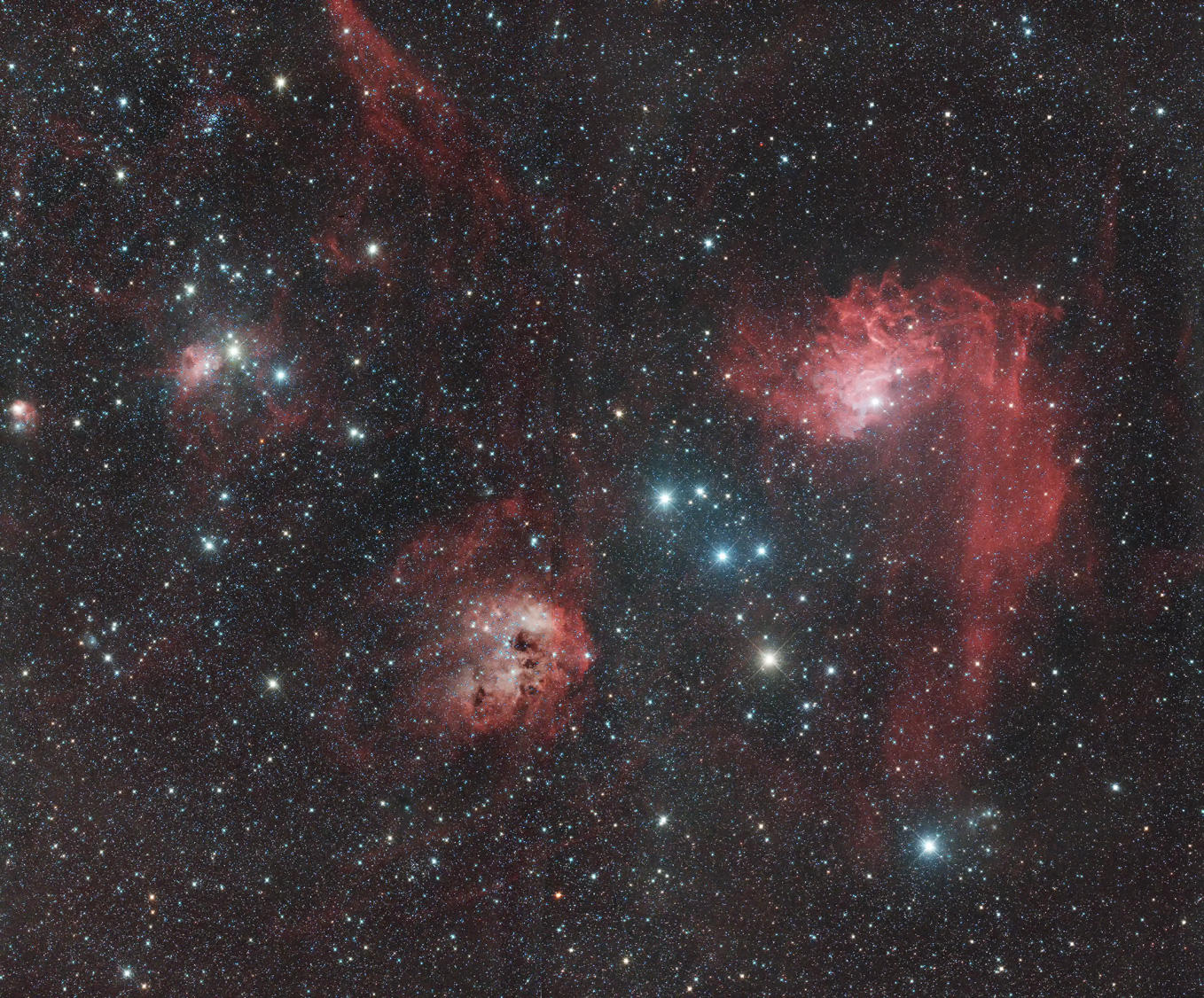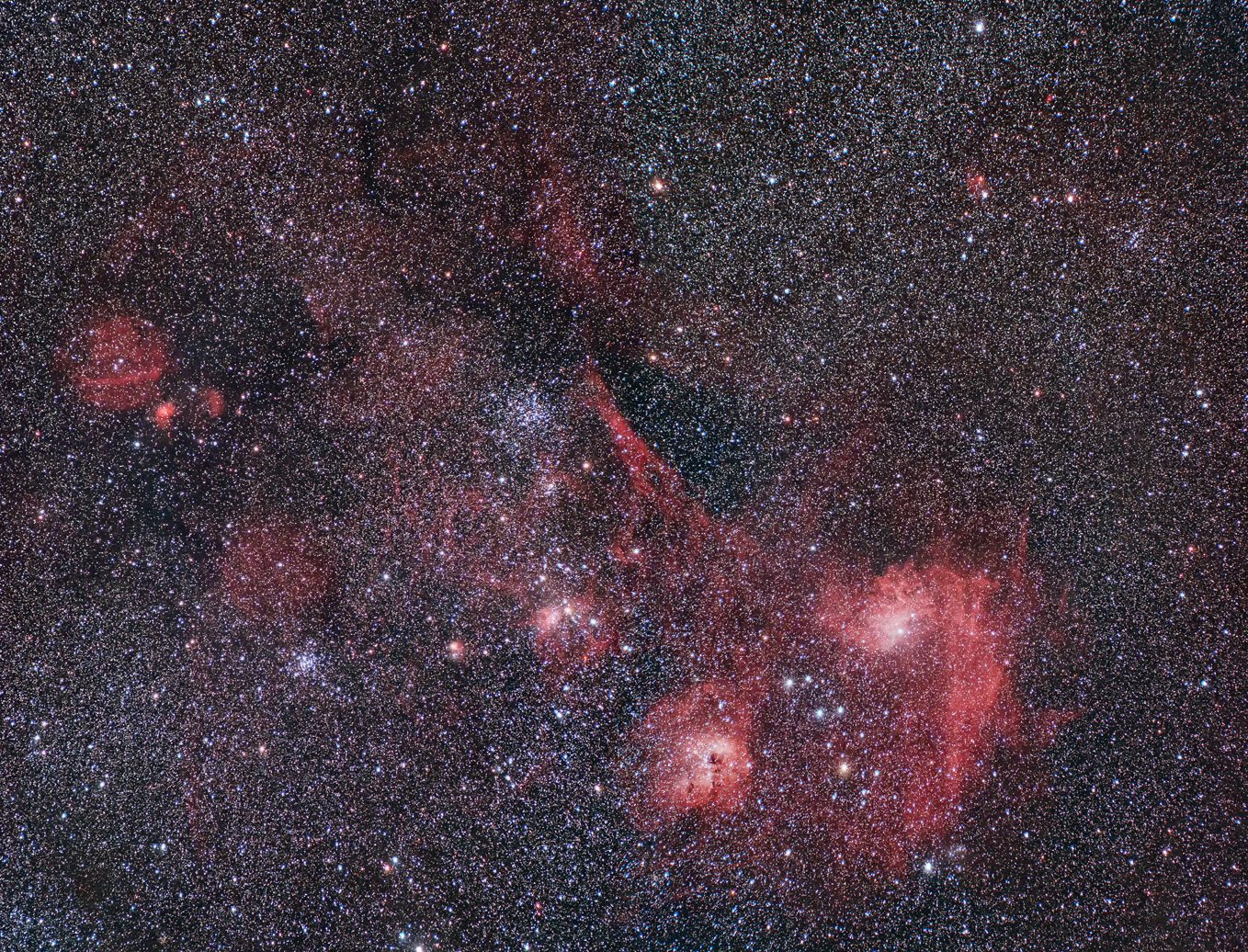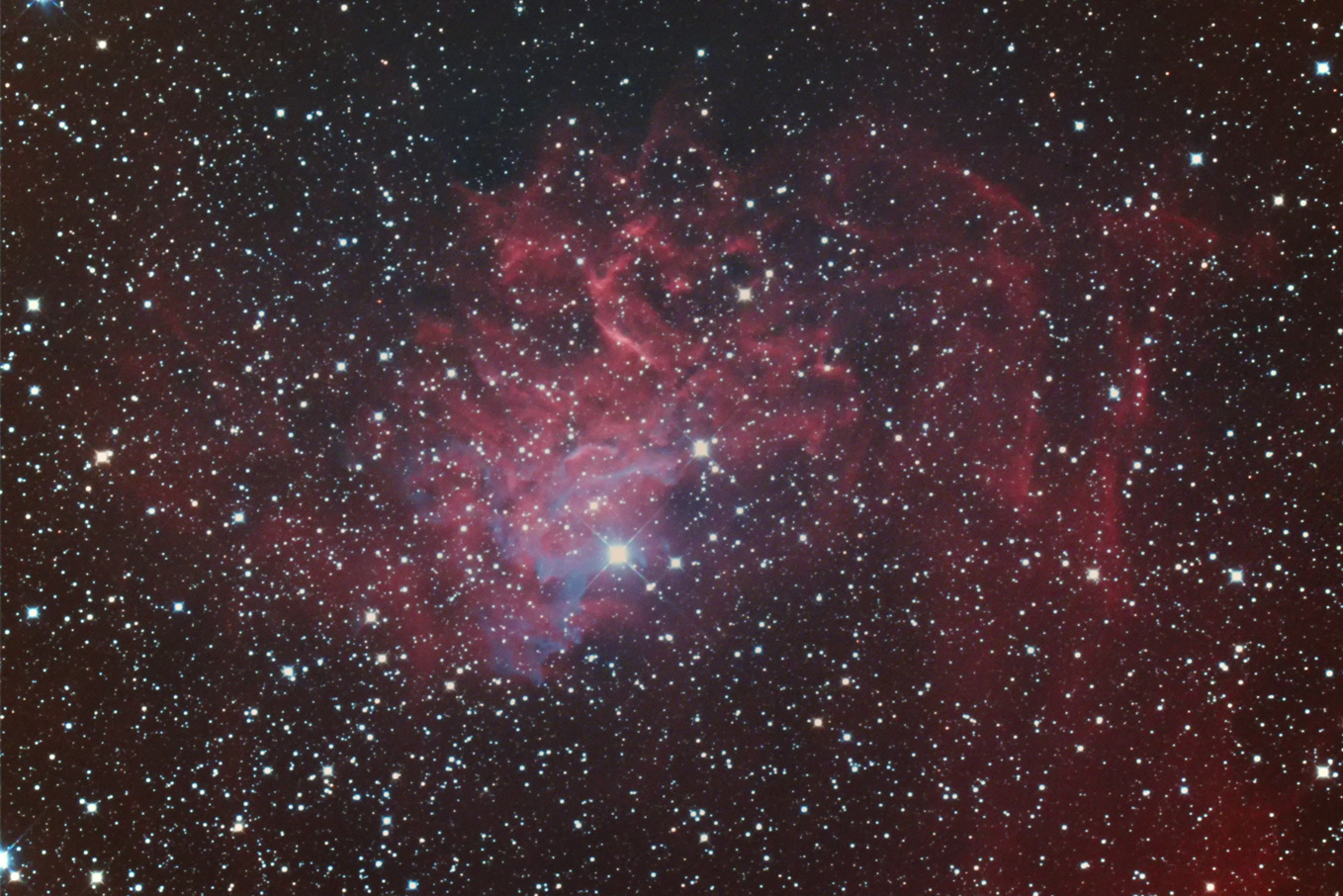Deep Sky Object in Winter
Around IC405, IC410 (Diffused Nebulae in Auriga)
Click on image to enlarge
| Date & Time: | Jan 25 2025, from 23:16 to 25:05 JST(+0900) |
| Composed 19 shots with 6 minutes exposed |
| Optical: | BORG 67FL with conversion lens (f=210mm, F3.4) |
| with IDAS LPS-V4 Light-pollution suppression filter |
| Auto-guided with TAKAHASHI JP Equatorial |
| Digital Camera: | Canon EOS 6D (Remodeled) |
| Location: | Ooizumi, Hokuto city, Yamanashi pref. |
| Camera Settings: | Recording Format...14bit CCD-RAW, converted to 16bit TIFF(3600×3200) |
| Device Size...23.6×21.0mm, Sensitivity...ISO2500 |
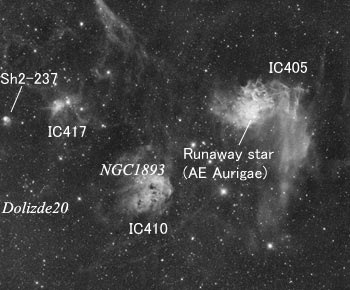
Objects around IC405,IC410
Italic indicates IDs of open clusters
|
This image captures faint diffuse nebulae spread within the pentagonal outline of the constellation Auriga, which lies almost at the zenith in the winter night sky.
On the right side of the frame is IC405, and to its left lies the round-shaped nebula IC410.
IC405 extends a faint band of gas westward from its bright circular region, giving the whole nebula a shape reminiscent of a comma.
Because of this appearance, it is affectionately nicknamed the "Magatama Nebula" in Japan, after the comma-shaped beads of ancient ornaments.
You can find the 6th-magnitude variable star AE Aurigae near the center of the IC405.
This star is also known as a "runaway star", believed to have been born in the Great Orion Nebula (M42) and ejected from it.
It happens to be passing through IC405 on its journey through space, and its light illuminates the nebula. Once the star moves away, IC405 will likely lose its glow and fade into a dark nebula.
Farther to the left in the image lies the smaller diffuse nebula IC417, located more than three times farther away than IC405 and IC410.
It shows several filamentary structures extending outward, earning it the nickname "Spider Nebula". About 1.5 degrees north of IC417 lies the open cluster M38.
|
| IC405 / Diffused Nebula, type 2 E |
|---|
| R.A. | 05h 16m 12.0s (2000.0) |
|---|
| Dec. | +34° 16' 00" (2000.0) |
|---|
| Apparent Size | 30×45' |
|---|
| Real Size | 19×12 light yrs. |
|---|
| Magnitude | - |
|---|
| Distance | 2200 light yrs. |
|---|
| Other IDs | LBN795 |
|---|
|
| IC410 / Diffused Nebula, type 2 E |
|---|
| R.A. | 05h 22m 36.0s (2000.0) |
|---|
| Dec. | +33° 31' 00" (2000.0) |
|---|
| Apparent Size | 23×20' |
|---|
| Real Size | 15×13 light yrs. |
|---|
| Magnitude | - |
|---|
| Distance | 2200 light yrs. |
|---|
| Other IDs | Sh2-236, LBN807 |
|---|
|
| IC417 / Diffused Nebula, type 2 E |
|---|
| R.A. | 05h 28m 17.0s (2000.0) |
|---|
| Dec. | +34° 25' 00" (2000.0) |
|---|
| Apparent Size | 13×8.5' |
|---|
| Real Size | 26 light yrs. |
|---|
| Magnitude | - |
|---|
| Distance | 7500 light yrs. |
|---|
| Other IDs | Sh2-234, LBN804 |
|---|
|
Click on image to enlarge
Wide-field image around IC405, IC410
| Date & Time: | Jan 25 2025, from 23:21 to 25:03 JST(+0900) |
| Composed 18 shots with 6 minutes exposed |
| Optical: | AF zoom-Nikkor 80-200mmF2.8ED (f=80mm, stop: F4.0) |
| with IDAS LPS-D1 Light-pollution suppression filter |
| Auto-guided with TAKAHASHI EM-200 Equatorial |
| CMOS Camera: | ZWO ASI2600MC Pro (Cooled temp.: -25°C) |
| Location: | Ooizumi, Hokuto city, Yamanashi pref. |
| Camera Settings: | Recording format...16bit FITS, converted to 16bit TIFF(6248×4176) |
| Device Size...23.5×15.7mm, Gain...100 |
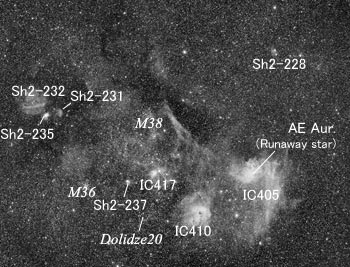
Objects around IC405,IC410
Italic indicates IDs of open clusters
|
This is a wide-field image covering a 16.7×11.1° area around IC405 and IC410.
To the east of these nebulae lie the three open clusters M36, M37, and M38, while to the north, faint emission nebulae such as Sh2-232 can be seen.
In addition, extremely faint diffuse and dark nebulae are scattered across almost the entire field of view.
|
Click on image to enlarge
Magnified image of IC405
| Date & Time: | Dec 4 2021, from 21:34 to 22:22 JST(+0900) |
| Composed 12 shots with 4 minutes exposed |
| Optical: | TAKAHASHI 16cm(6.3") epsilon (f=530mm, F3.3) |
| with IDAS LPS-D1 Light-pollution suppression filter |
| Auto-guided with TAKAHASHI JP Equatorial |
| CMOS Camera: | ZWO ASI183MC |
| Location: | Ooizumi, Hokuto city, Yamanashi pref. |
| Camera Settings: | Recording format...32bit FITS(2×2 binning), converted to 16bit TIFF(2744×1836) |
| Device Size...13.2×8.8mm, Gain...400 |
This image shows you a magnified field of the northern part of IC405. A glittering star a bit lower central part is AE Aurigae (Runaway Star).
You can detect that the surrounding region is reflecting bluish light of the star directly, and the outer region is emitting reddish Hα light from the activated hydrogen atoms.
